Two law firms hit gender parity – and credit WFH

Just two law firms had at least as many female partners as males this year, and leaders say providing work-from-home flexibility to staff helped them reach the milestone.
Hicksons and Lander & Rogers topped the list of firms with the highest proportion of female partners in The Australian Financial Review Law Partnership Survey, which showed a steady improvement in gender representation across the industry.

Lander & Rogers partners Jackie Solakovski, Genevieve Collins and Joanna Renkin. Eamon Gallagher
Women accounted for almost 35 per cent of all partners in the second-half Law Partnership Survey, up from 32 per cent at the start of the year. That figure represents a steady increase from five years prior, when only 25 per cent of law firm partners were women.
At a time when many firms were demanding staff spend more time in the office after the pandemic era of working remotely, Landers & Rogers and Hicksons leaders said work flexibility had helped them achieve the record on gender equality.
Lander & Rogers had maintained a “fully flexible and hybrid work policy with no mandated number of days in the office” as part of a concerted effort to “understand drivers and impediments to gender equality”, chief executive partner Genevieve Collins said.
Stewart Cameron, Hicksons’ managing partner, said the firm had part-time and fully remote partners working overseas and interstate, and had embraced remote working well before the pandemic.
“People seem to like it, and they’re staying with us, so we are able to get the progression from senior associate level to the partnership,” he said.
The firm has no requirement for staff to spend a minimum number of days in the office.

The two firms with 50 per cent or more female partners said rivals could not assume the high percentage of women in fee-earning roles would naturally filter upwards.
“When I was at law school in the 80s, we had a 50-50 split back then, but we are still yet to see gender parity at partnership level,” Ms Collins said.
The latest survey showed that almost half of new partner appointments in the second half of the year were women. They have never accounted for a majority of new partner appointments, despite representing at least 60 per cent of the senior associate cohort since 2016.
Ashurst was the best represented of the big firms. Women made up 43 per cent of its local partnership, while Gilbert + Tobin met its 40 per cent target for the first time.
Despite the progress, laggards remain. At a third of the surveyed firms, women made up less than 30 per cent of the partners. At prominent firms Thomson Geer, Arnold Bloch Leibler and Allen & Overy, they accounted for less than 25 per cent.
No accident
Ms Collins said firms needed to act to achieve gender equality at senior levels.
“If they genuinely wanted to achieve gender equality, there’s no reason why they can’t, because more women are progressing through the profession than ever before,” she said.
Lander & Rogers updated its parental leave and flexible working policies to attract and retain high-achieving women. But Ms Collins said “it’s not about any one initiative or policy. It’s about an organisation’s entire culture, leadership and operating model”.
“There has to be a collective desire and focus to achieve gender equality.”
Gilbert + Tobin cracked its long-held 40 per cent gender balance target in the latest survey. All three of its partner recruits in the past six months were women.
Chief executive Sam Nickless said the firm made recruiters aware it was looking for female candidates for partner-level roles.
It had a well-established cohort of senior female partners – Gilbert + Tobin has consistently had more female partners than its big rivals – who served as role models.
“We’ve had a critical mass that we have been able to build upon,” Mr Nickless said.
Ashurst had the greatest proportion of female partners of the big firms, at 43per cent; for the other firms, the figure hovered around 35 per cent.
Corrs Chambers Westgarth and Clayton Utz were laggards. Fewer than 30 per cent of the Corrs and Clayton Utz partnerships were women. The latter has hired six partners since July, only one of them female.
Little progress
Arnold Bloch Leibler and Allen & Overy remained the worst performers on partner parity.
Only four of Allen & Overy’s 25 local partners are women. Australian managing partner Jason Denisenko said the firm was making progress on targets, but “we are not where we want to be”.
The firm had doubled the number of female partners, from two last year, and greater diversity “is profoundly important and essential to our future success”.
At Melbourne-based Arnold Bloch Leibler, fewer than 20 per cent of partners were women, a figure that has not changed in the past decade.
Shaneen Argall, the firm’s director of human resources, said: “We have a very stable partnership where long tenure is the norm … ABL is a place where neither the size nor expansion of the firm has been considered a proxy for success.
“While this is a noble approach that has many benefits, it precludes the firm from achieving a quick fix when it comes to gender parity in the partnership.”
Read more on the second-half Law Partnership Survey
- Firms hit pause on expanding partnerships amid slow market Less than half of Australia’s largest legal partnerships have grown in the last six months and the number of partners at the 50 largest firms are up just 0.3 per cent, as a flat legal market begins to take hold across the sector.
- Australia’s largest law firms slow partner appointments The full January 2024 list featuring the largest firms in the country by partner number.
- Law firms see opportunity in their own cyber vulnerability Law firms are eying cybersecurity as the industry’s new growth area, and say they can use their own experience as victims and targets of cyberattacks to help clients manage risk.
Introducing your Newsfeed
Follow the topics, people and companies that matter to you.
Find out moreRead More
Latest In Professional services
Fetching latest articles